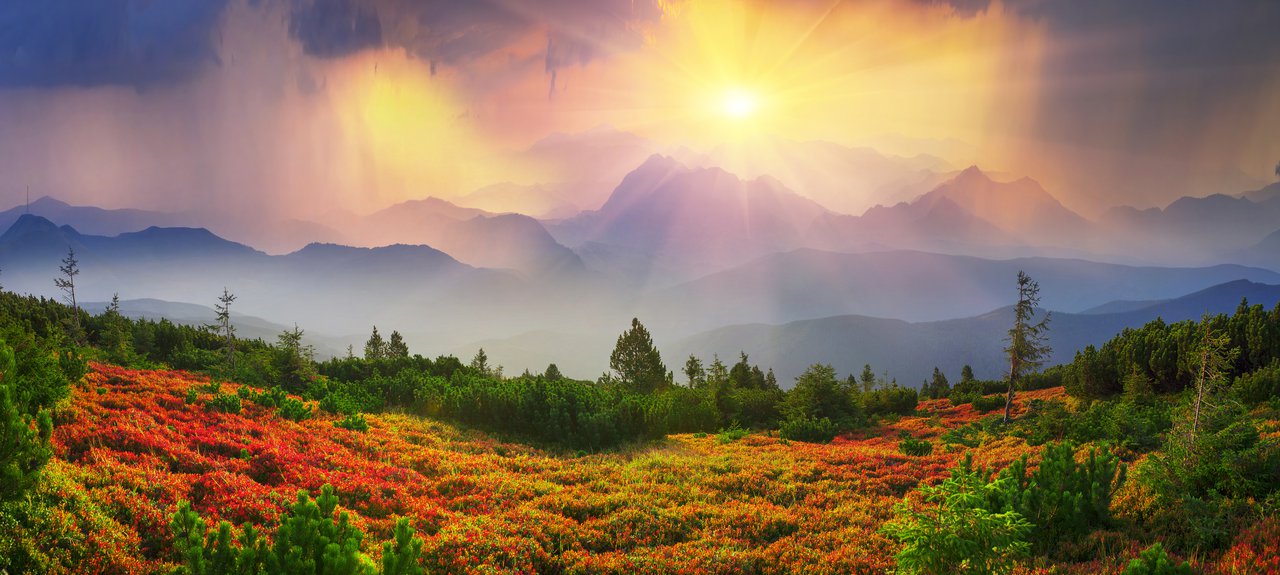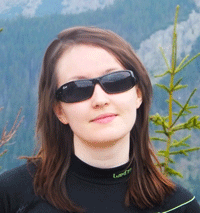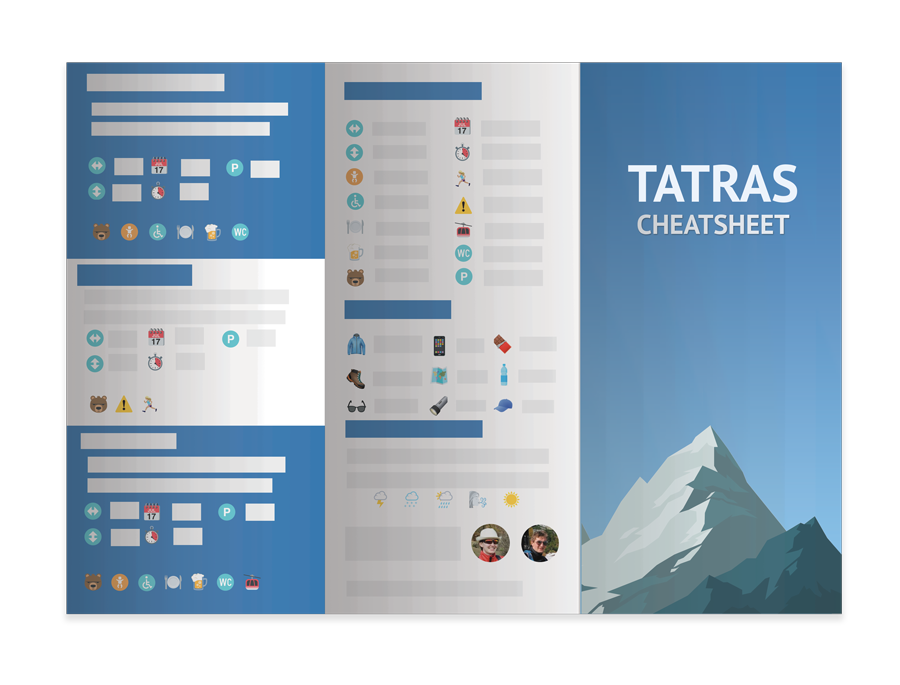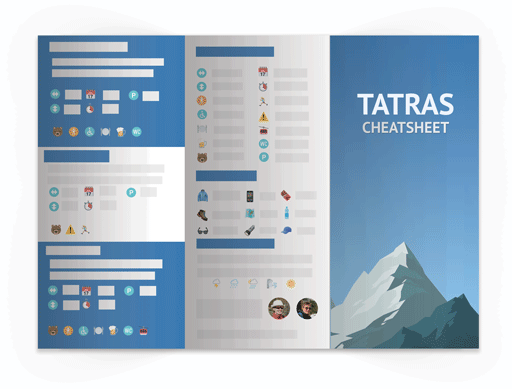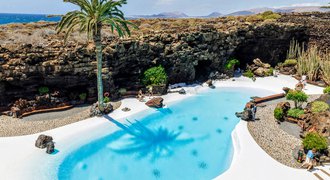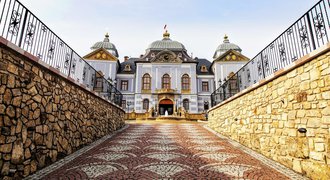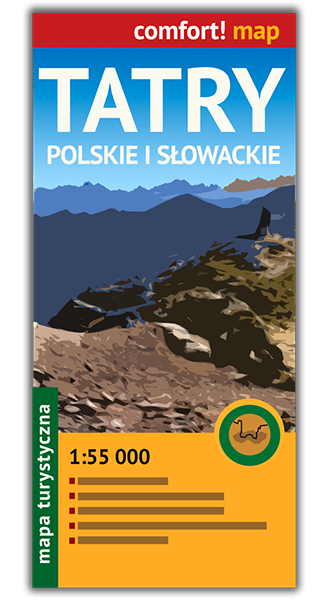“Spectacular achievement is always preceded by unspectacular preparation.”
– Robert H. Schuller
Weather is a crucial factor which we have to take into consideration when preparing for our mountain trip.
So, one of the most important things which we need to keep in mind when we visit Tatra mountains is their unpredictable weather – it can change in the blink of an eye.
Especially High Tatras weather can be very capricious and winter may start there in September.
Tatra highlanders say that they have 10 months of winter, and the rest of the year is summer.
This is, of course, an exaggeration and there are many days when the sun is shining like crazy, the views take your breath away and you're thankful for the fabulous mountains in Poland.
But still, it’s crucial to come prepared, as the weather in the mountains tends to be capricious.
In this article you gain following knowledge
 Don't miss other valuable Tatra Mountains articles
Don't miss other valuable Tatra Mountains articles
Hiking in Tatra Mountains
📌 If you would like to explore this amazing region, check out 6 fantastic Tatra Mountains resorts and enjoy your trip to the fullest.
📌 For a hiking guide, have a look at this list of 6 fantastic hikes in Tatra Mountains. It includes maps, detailed trail descriptions, practical info about Tatra National Park and hiking tips.
📌 Polish mountains - hiking guide.
📌 Tatra Mountains map - don't rely solely on electronic devices.
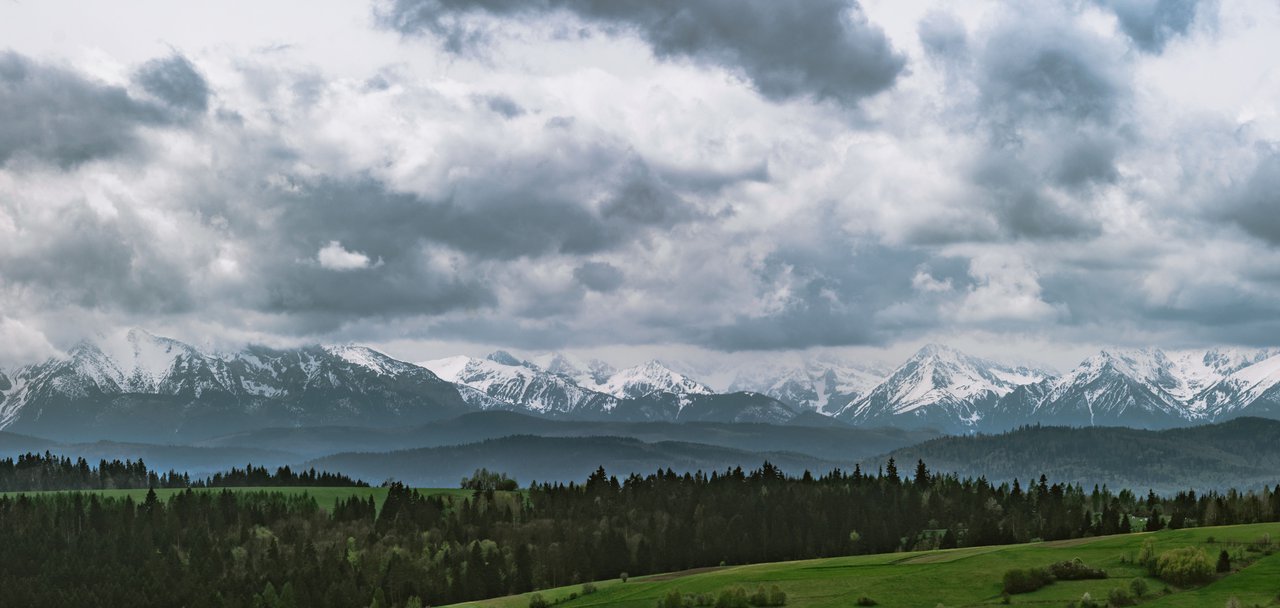
Panorama of Tatra range © Kazick / Adobe Stock
What are daily average temperatures in Tatra mountains?
In the picture below there are the average min and max of daily temperatures in the given month for the Tatra mountains.
Note that these are for Morskie Oko located in the High Tatras at the altitude of 4612 ft (1406 m).
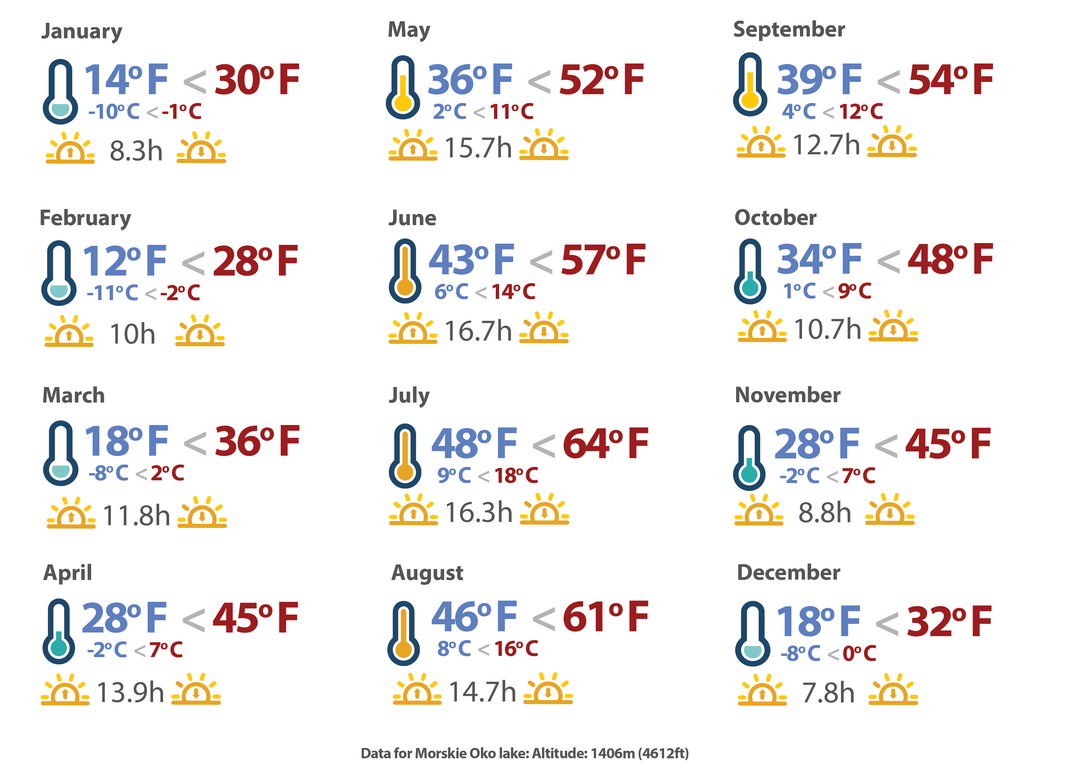
What does average max and min actually say to us?

Every day in a given month the lowest temperature measurement is recorded. Then all records are used to calculate the average min temperature of the month. The amplitude is around 15 degree so we may expect the coldest temp in the coldest day in a given month could be 21 F and least cold temperature in one day would be around 41 F. (the coldest time of a day happens usually in the middle of the night).

Same way with the max temperature. The highest temperature measurement is recorded for every day. Then all records are used to calculate the average max temperature of the month. The amplitude is around 15 degree so we may expect the hottest temp in the hottest day in a given month could be 67 F and least hot temperature in one day would be around 37 F. (hottest time of a day happens usually in the middle of the daytime).
Altitude difference
The higher we climb, the colder it gets. Also, the wind is getting stronger which can cause sudden body temperature loss.
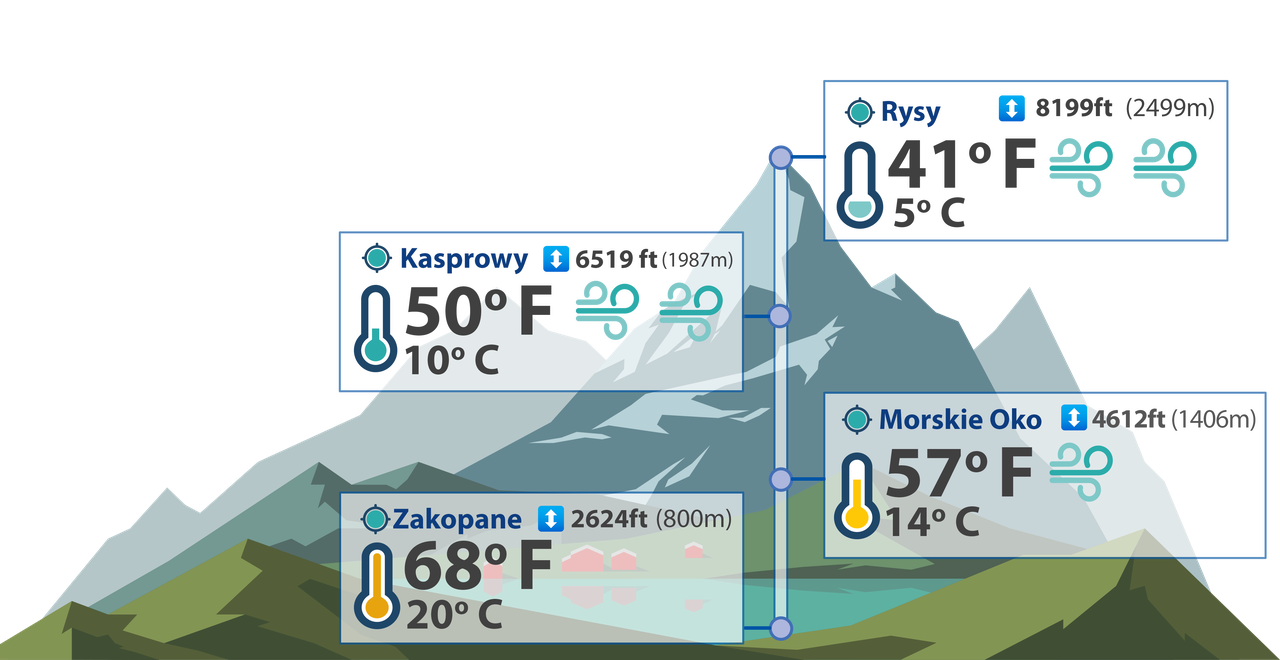
With altitude changes, your cloth layers have to adapt as well.
- Have multilayer clothing
- Try to change your clothes before you are too cold or too warm
- Even though it may seem ridiculous to take warm clothes on a hot day you should always have a backup
- Softshells and zip fleece are what we usually use and they do the trick
Note: sometimes during summertime inversion happens 🙃
Here are some of the most usual weather caprices which you can expect when hiking in Tatra National Park:
Rain in Tatra mountains
In the video, we are climbing down from Rysy (the highest mountain in Poland) during quite heavy rain. Rocks and ladders were very slippery.
Probability
Rain is most common during warmer months May, June, July and August and they all have on average 50% more days with rain. The rainy conditions may be very uncomfortable and dangerous when happen together with strong wind - usually on mountain rigs and peaks.
But on most days, the rain occurs early afternoon or later in the evening. Usually rains very intensively for a short period of time 30 minutes to a few hours. On hot days it's accompanied by thunderstorms.
For Morskie Oko (basically the middle of the Tatras) the weather measurements show most days with rain has June with number 22 The least rainy month is November but it has far lower temperatures on average 10ºC colder than summertime. It has only 8.5 rainy days plus 6 snowfalls on average in November.
The best month for hiking near Zakopane is October having only 11 rainy days and 10.5 days with clouds covering the sky less than 80%.
The second best is a bit warmer and with longer daytime, the September. It has on average 7 sunny days and 16 days with rain episodes.
Note: By rainy day I mean a day with any rain. Even a day with 30 minutes of rain still counts as rainy here.
Advice
What to keep in mind?
- Make sure you have a dry place for your electronics in case of heavy rain
- If the weather is uncertain plan routes near shelter huts
- Take a rain poncho with you even though the weather forecast looks good
- In higher parts, the rain will slow down your walking speed because extra attention is needed for slippery rocks
- In summer you may decide to start your hike very early to minimize the risk of rain or storm
- It's nice to have warm tea in a thermos flask
- Rain in the morning doesn't necessarily mean it will be like that all day. In this climate, weather changes usually multiple times during the day
- Have good hiking boots. I wear Lowa boots and I wrote about them here.
Fog in the mountains
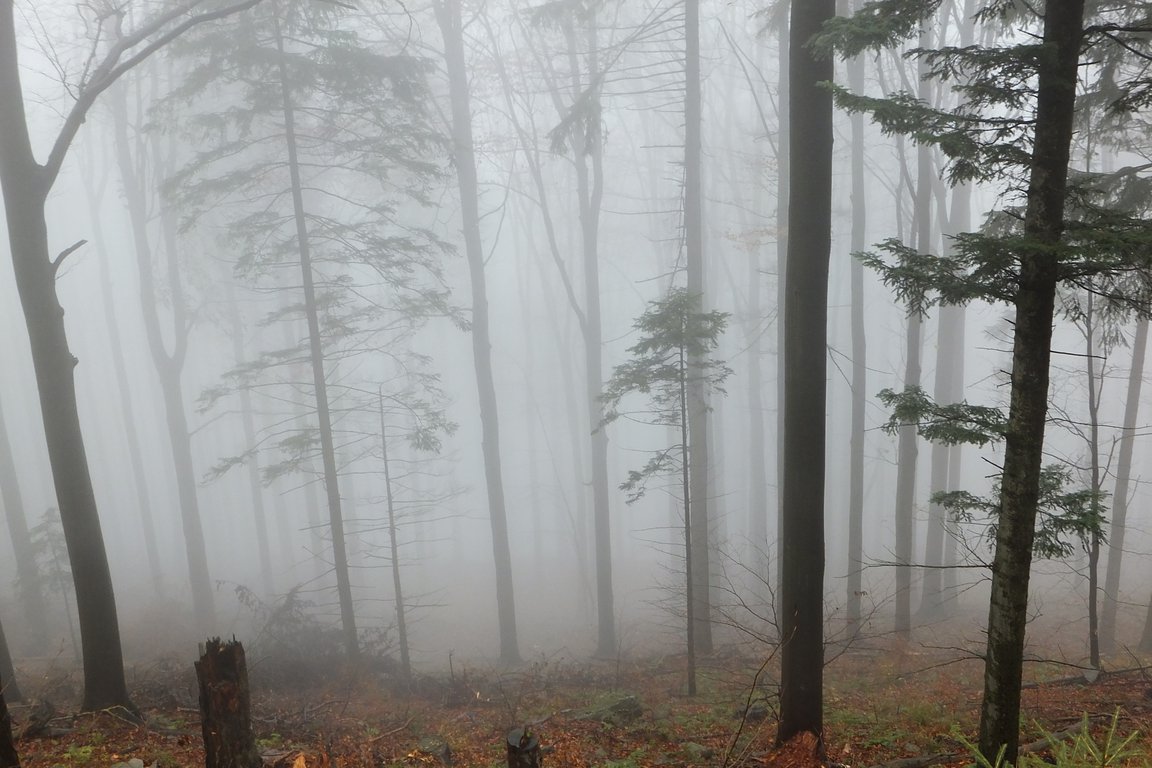
We encountered such a dense fog many times while hiking in Polish mountains.
Probability
More often in the months of September, October, November and December.
In the mountains, fog is a very common weather condition. The higher we go the bigger chance we have to encounter thick clouds of moisture.
Reading reports of TOPR Tatra Volunteer Rescue Unit I can conclude that fog is one of the most frequent reasons hikers get lost. It is very easy to lose orientation and miss the route signs. When we combine fog with the snow it becomes even more dangerous as route signs are often under the snow or covered with ice.
Video showing the fog and low visibility
Video showing Joanna in weather conditions in which is really easy to get lost
Advice for the fog in the mountains
- Always inform someone exactly where will you be hiking and when you plan to come back
- Have a paper map and a good compass with you
- Take the headlight to the backpack
- Carry emergency thermal blankets
- Take a fully charged power bank for your mobile phone
- Have installed the application Ratunek - for Emergency calls integrated with GPS localization
Hailstorm and thunderstorm in the mountains
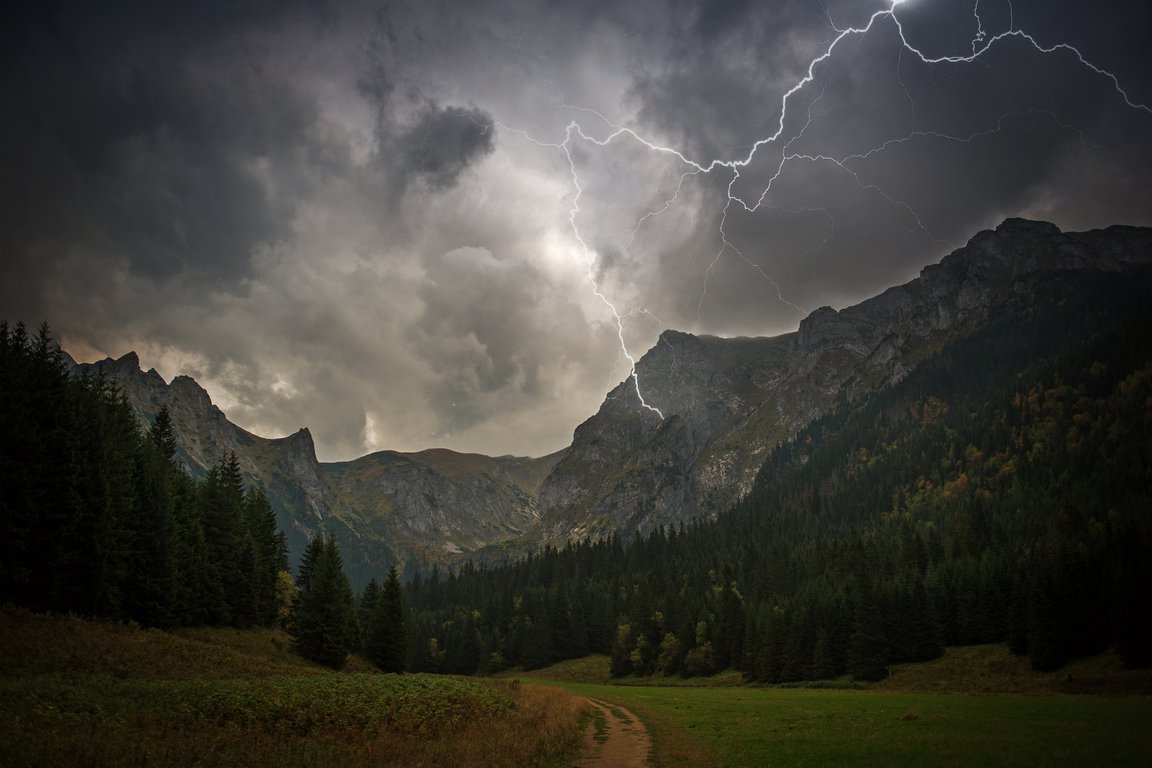
The picture was taken on Wielka Polana in Dolinie Małej Łąki (Valley of the Little Meadow) capturing the lightning strike. © Tomasz Zajda / Adobe Stock
Thunderstorms are very common in the Tatra mountains. The highest number can be observed in June, July and August.
Thunderstorms can be deadly in 2019 a single lighting hit tourists on the Giewont peak in Poland killing 5 people and hospitalizing over 100.
Happen most often in the afternoon and are very dangerous in the mountains. Generally, the best idea is to start off your hike as early as possible in the morning in the summertime.
What to do when a thunderstorm catches you suddenly on your hike in Tatra mountains?
- Rescue experts say the chance of lightning strike may be 10 times greater on the exposed rocks in higher parts of the mountain - it is advised to descend as soon as possible to the valleys before the thunderstorm
- If you hike in a group spread out
- Keep away from streams, ponds and water sources
- Stay away from metal infrastructures like antennas, chains or cables
- Find an unexposed place and sit on your backpack with legs joined together
You can monitor and get alerted about lighting nearby with this Apple app.
How to hike in the snow?
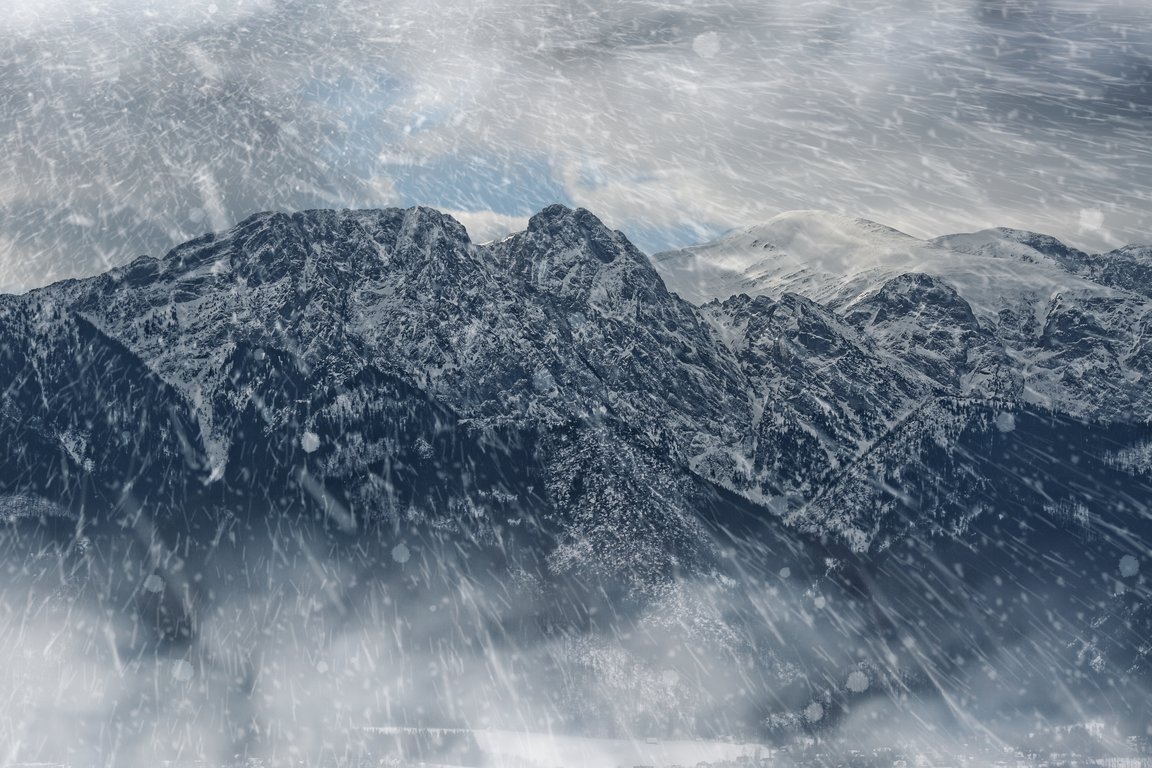
Picture of the Giewont Mountain seen from Zakopane during a snowy day. © ambrozinio / Adobe Stock
Occurrence
The snowfall can occur even in June or at the beginning of July (especially in higher parts on the north side of the slopes). Fresh snow may fall in September.
Beware – because of quite big temperature differences, such snow might create a thin layer of ice on the trail. Then, it’s too slippery for regular hiking shoes, but also too thin for crampons. In such conditions, it's better to give up hiking (especially in higher parts).
Risks
The deadliest danger in the Tatra mountains is the avalanches. Statistics from the years 1909 - 2009 show that 90 people have died in avalanches in Tatra mountains.
It is quite difficult to hike in snow as the ground may be more slippery and create an additional hazard for your health.
Video of hiking in the snow
Difficulties of hiking in snow. In the video, we hike around Black Pond (Czarny Staw Gąsienicowy) and Kasprowy in sunny clips
Advices for snow hiking:
- Protective clothes. I recommend a skiing jacket. Our favourite brand is killtec
- We use GORE-TEX shoe gaiters to keep your boots dry
- Always check avalanche alerts: lawiny.topr.pl
- Hiking in snow is much more difficult and takes more time to cover the same distance
- Ice axe provides additional protection
- Have detachable shoe spikes
- Hiking or Walking Sticks with a sharp ending
- We absolutely advise against hiking in areas where there's a risk of an avalanche
- Come prepared - read about winter hiking and stay safe on the trail
Ice in the Tatras
The video shows the difficulties we had while trying to hike on icy ground.
Ice on the trail forms usually at night from melted snow during sunny days. It's a very common condition. Sometimes the entire trail may be closed due to dangeres of ice.
It can also be partly caused by walking. While many hikers step on the path areas snow will get compressed so much it will eventually form ice.
Ice on the trail is not always visible. It is often hidden under a thin layer of soft snow.
Safety tips:
- Avoid walking on icy trails
- Carry an ice axe if you plan to hike above valleys
- Crampons are indispensable for winter hiking in high mountains. For valleys or low mountains use microspikes
- Have a hiking helmet to protect your head if you slip
Sun in the mountains
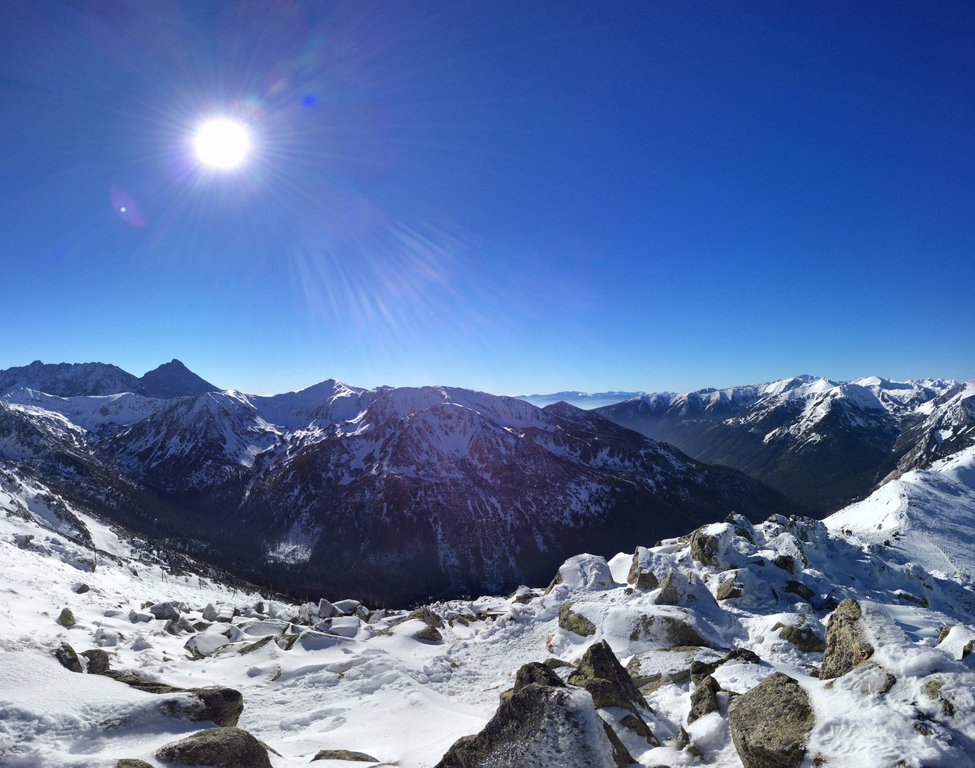
Western Tatras: view from the ridge near Kasprowy mountain showing the Ticha Valley (Silent Valley) in Slovakia Tatras.
We all desire sunny weather for our hiking trips but there are a few things we should be aware of.
Sun can be more dangerous in winter and spring when there is still snow in the mountains. On a sunny day, fresh snow can reflect up to 90% of UV radiation. This leads to exposure to a double dose of UV – directly from the sun and bouncing off snow-covered surfaces.
What are the risks of such a situation?
- Heatstroke
- Sunburn
- Eyes damage and even temporary loss of sight
It's good to:
- Wear protective sunglasses or goggles
- Use a sun cream with a high UV filter in summer and winter
- Avoid exposing yourself to the sun for a long period of time
- Wear a hat
- Make sure you drink plenty of water
Wind in the Tatra Mountains
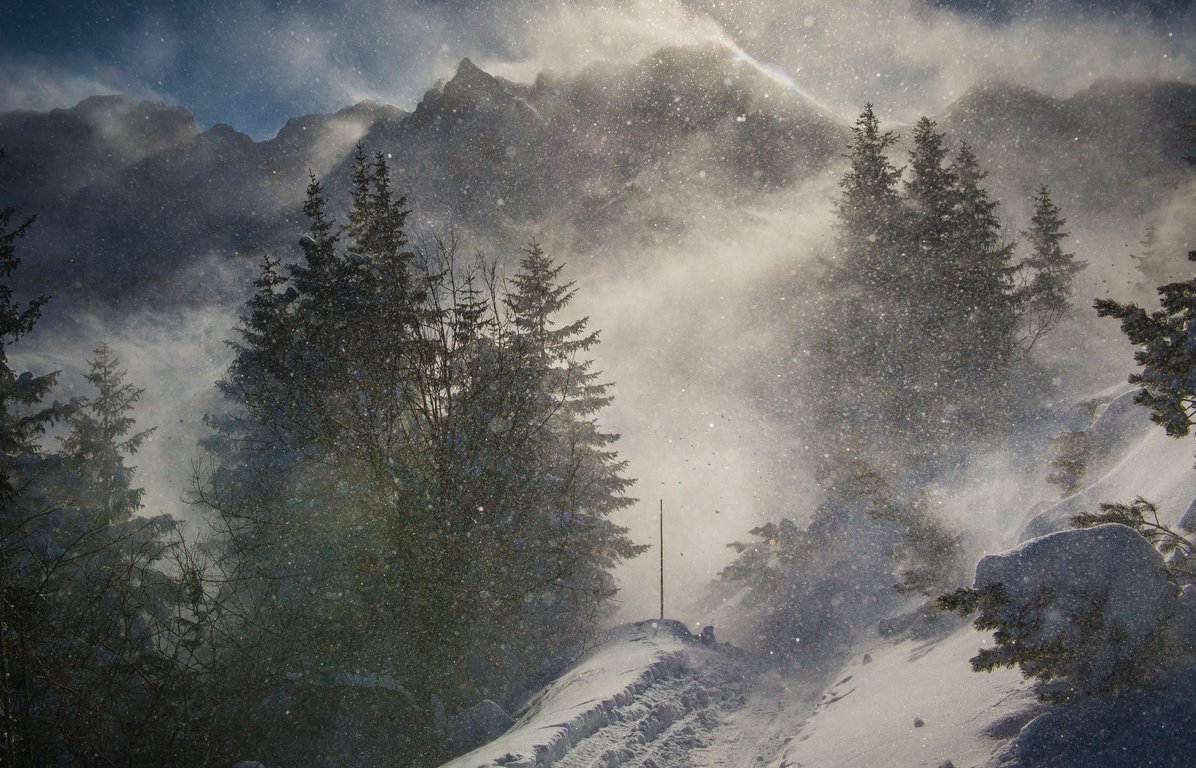
Extremely strong wind in Hala Gąsienicowa in Tatra Mountains Poland © grzegorz_pakula / Adobe Stock
There are no days without wind in Tatras. The climate of the mountains creates local wind forces even though the areas around the mountains are still.
The wind speed on the peak of the mountains is usually 50 - 62 mi per hour (or 80 - 100 km per hour).
Video showing strong wind in the mountains:
In such conditions on the exposed peaks and ridges, we lose a lot of body warmth. To prevent it remember to:
- Limit the time spent on wind-exposed ridges
- Have wind-protective clothes
- Check weather forecasts to avoid extreme wind conditions
- The face mask is a nice addition to wind protection
When I was hiking in Tatra National Park, I had a chance to experience several weather “attractions” on one day – fog in the morning, then sun, in the afternoon strong wind which blew rainy clouds. The temperature dropped a lot and in higher parts it was snowing. Such unstable weather happens especially in the spring and autumn.
For that reason, it’s essential to have a jacket or raincoat, fleece jumper and good hiking boots.
Early spring and autumn require additional stuff – beanie, gloves, windproof trousers, thermo-active underwear.
In the summer we will need sunscreen and a hat. The sun's strength isn’t always so obvious in the mountains, but it’s very easy to get a sunburn.
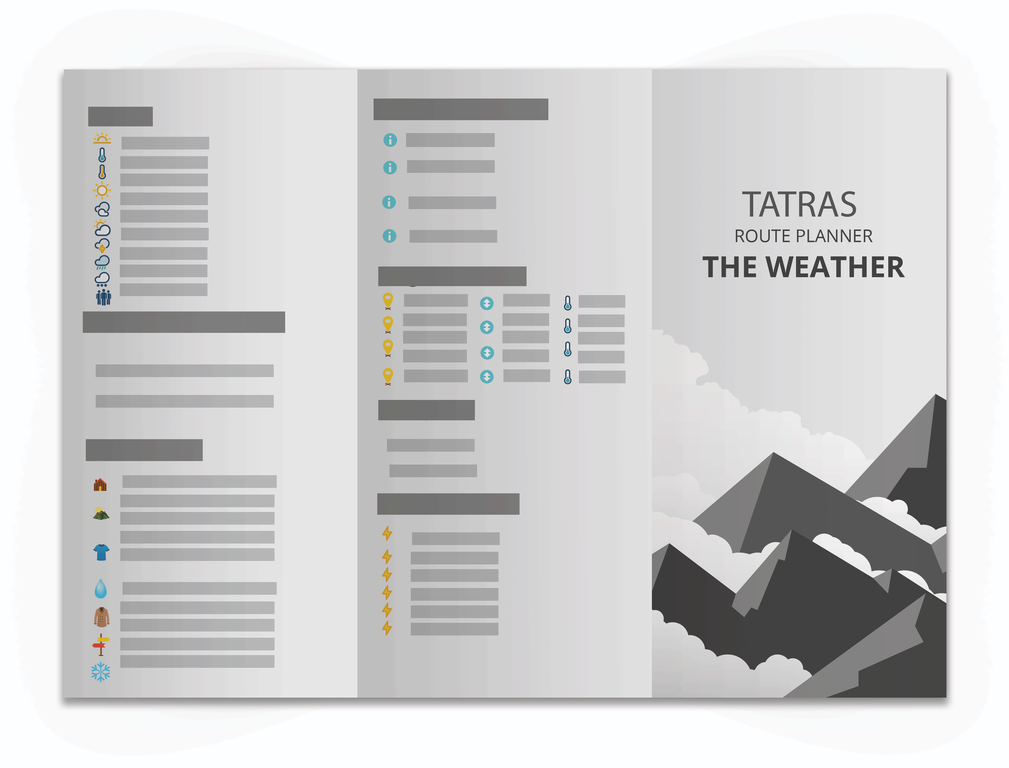
Also, download and print our Weather Guide for Tatra Mountains. It contains helpful information regarding weather conditions and mountain climates for your trip planning. You can get it by purchasing our Premium Cheatsheets Bundle here.
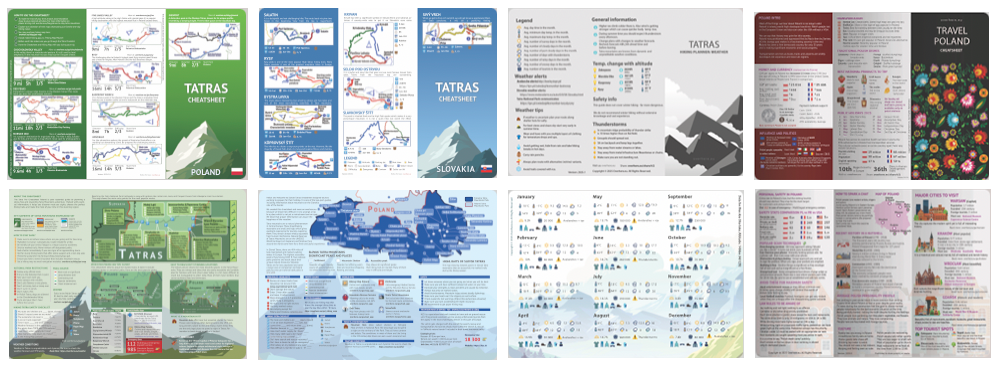
Bundle of Premium Cheatsheets
Weather phenomena in Tatra mountains - Halny wind (Foehn wind)
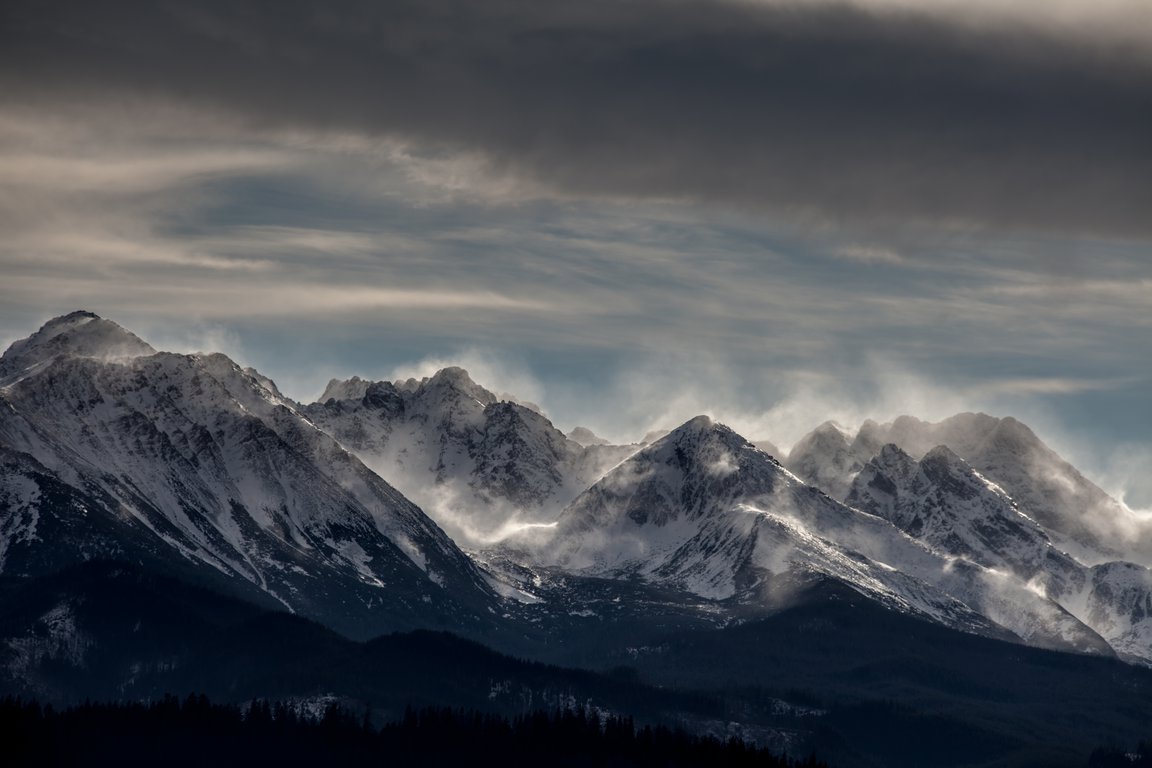
Foehn Wind in Tatra mountains © burasek79 / Adobe Stock
It is usually a very strong wind blowing dry and warm air into the valleys. It can be very sudden and cause a lot of infrastructure damage.
Halny wind also influences people's mood. Because atmospheric pressure changes rapidly, people with cardiovascular and heart diseases may experience additional difficulties.
Halny wind also influences the minds, people become nervous and grumpy. Suicide rate rises. Interestingly, there are reports which state that animals act strangely during that time.
It most often occurs in autumn and early spring.
Source:
Wikipedia: Wiatr Halny, Wikipedia: Fen
You may find useful information about weather conditions on the below pages:
⇒ TOPR – Tatra mountains official website which streams live video from several mountain huts thanks to the CCTV system. Unfortunately, only the Polish version of the website is available, but Google will happily translate it for you. 😉
⇒ HZS – life rescue service in Slovakia. There's lots of useful information on their website, but again, the English version isn't available.
Emergency numbers :
⇒ TOPR in Poland: 601 100 300
⇒ HZS in Slovakia, High Tatra: 0903-624-869
⇒ HZS in Slovakia, Western Tatra: 0903-624-066
Here's a handful of weather websites where you can check actual conditions in Tatra mountains:
OK, now another link, not connected with the weather, but really good to know if you plan to hike in Polish mountains - mapa-turystyczna.
It's the most user-friendly online map I know. It will not only help you to choose the route - but this website also shows the time of walking, and altitude difference and informs about trail closures. It's very very helpful, this one.
⇒ Always hike with a paper map, don't rely only on electronic devices. Here you'll get a paper Tatra Mountains map.

